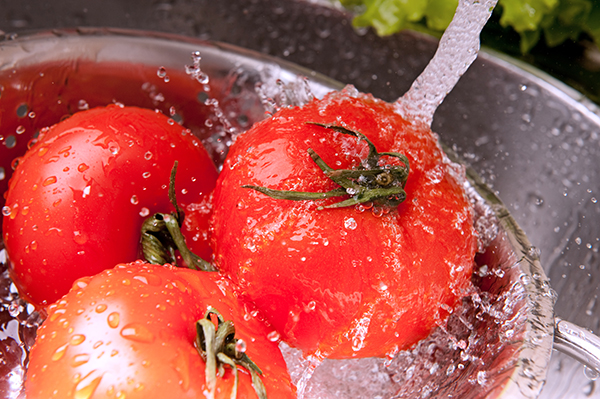Be Aware When You Prepare – Food Prep Tips

Food Prep Steps — Regardless of how many steps may be involved in food production and service, foodborne illness prevention requires effective food safety measures that ensure good personal hygiene, avoiding cross-contamination and temperature abuse. In small food establishments, such as a convenience store or sandwich shops, the steps for storage, preparation, and service is a fairly simple sequence done by one or two crew members. In large restaurants, supermarkets, or institutional feeding facilities, food production may span several hours or days in many more complex steps done by several food workers. Educating all workers about preparation hazards is a crucial task for managers.
The Preparation Principles include these basics:
Control time and temperature. Keep food out of the temperature danger zone of 41°F to 135°F (5°C to 57°C) as much as possible. Prepare food in small batches. Use “batch preparation” methods to only take as much food out for preparation in room temperature conditions as you can handle in a short period of time. Refrigerate food if interrupted during preparation. Refrigerate or cook food as soon as you are done with preparation.
Always pre-chill ingredients and dressings for any cold salad or cold dish before mixing them together, such as chicken or tuna salad, potato or pasta salad.
Always cook food to the required minimum internal temperature to keep it safe. Check the minimum internal cooking temperature or core temp. for each food with a stem thermometer. Temperatures vary from food to food, so check the FDA Food Code as well as your local state requirements.
[download id=”818″]Cool food rapidly. Use the 2 stage cooling method. Stage 1: Cool food from 135°F to 70°F (57°C to 21°C) within 2 hours. Stage 2: from 70°F to 41°F (21°C to 5°C) or lower in an additional 4 hours or less. To cool food quickly: divide the food into smaller portions, put the food containers in an ice-water bath, and stir regularly with an ice paddle if a liquid food. Use shallow pans – metal cools faster than plastic. You can also use a blast chiller to cool the food more rapidly. Do not cover hot foods tightly – the faster the heat is allowed to be removed, the safer your food. Improperly cooling hot foods is the #1 bacterial cause of foodborne illness.
There are 4 acceptable ways to thaw food safely. 1) In a refrigerator at 41°F (5°C) or lower. 2) Under running water at 70°F or lower. 3) In a microwave oven, if the food is small enough. 4) As part of the cooking process.
Prevent cross-contamination. Wash your hands before working with each food type (raw vs. ready-to-eat foods). After handwashing, follow a policy of no bare hand contact with ready-to-eat food as an additional food safety barrier by using utensils, gloves or paper wraps at the appropriate steps. Mistakes in the handwashing and hygiene area account for the #1 cause of all foodborne illness outbreaks. Use different cutting boards to keep raw and ready-to-eat food separate. Clean and sanitize equipment and work surfaces after each task.
Bottom Line: Think ahead – allow enough time for thawing, cooking, and cooling within the safety limits of the “temperature danger zone”. Talk you your crew about their role in safe preparation of food and be specific about the tasks they do. Each crew member may not be involved in all the preparation activities mentioned above, but it is important to remember the general principles for food safety and to follow the “prep step” rules at your workplace.
***
About the Author: Lacie Thrall

READ MORE POSTS
Emergency Preparedness and Responding to a Disaster with Food Safety in Mind
As I write the first blog this month, the realities of the devastation in Florida are coming to light as we also deal with the aftermath of Hurricane Fiona, which impacted Puerto Rico late in September. Recent news has been focused on the recovery efforts for all who have been impacted. Thus, I thought it would be fitting this month to discuss emergency disaster planning resources in our first blog and delve into recovering from a disaster in our second blog later this month.
During National Food Safety Education Month is it time for Your Food Safety Refresher?
You see them in every restaurant and commercial foodservice operation across the United States. Framed and proudly displayed, often by the kitchen, the cashier, the kitchen entrance, or the service counter - just as they should be. To what am I referring? The food safety certification certificates, of course!
Welcome to National Food Safety Education Month!
In September of each year, we not only have the opportunity to celebrate Labor Day, but we also welcome National Food Safety Education Month! It is this time of the year when it is important to remember that Foodborne illnesses are still a major concern in the United States, although I am guessing many Americans don’t think about the safety of the food they eat as they go throughout their daily lives. The statistics show one in every six Americans will suffer from a foodborne illness each year, for a total of about 48 million cases each year.
Protecting Fresh Produce Post-Harvest, Integral to Safe Food
During the height of the summer, at least in the Midwest, farmers markets are in full swing and fresh produce is plentiful. Every backyard gardener is reaping the benefits of their work, with bountiful harvests of tomatoes and cucumbers. Everyone seems to have a neighbor who is trying to pawn off his or her over-production of cucumbers or summer squash during this time of year. When picking up that produce at the farmer’s market or from your neighbor down the street, have you ever given any thought to the microbial safety of it? Honestly, even in my position, it certainly is NOT the first thing that comes to my mind. But, earlier this month, I came across a news story out of Wisconsin discussing a Salmonella outbreak associated with shelled peas sold at a local farmers market. Who would have thought shelled peas would be impacted? The story noted, and it served as a great reminder, that most outbreaks associated with Salmonella in produce are due to mistakes made in handling or transportation of produce after harvesting.










